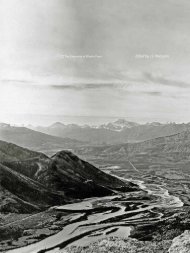C Ihe Ladies c cu. V'VVAN - History and Classics, Department of
C Ihe Ladies c cu. V'VVAN - History and Classics, Department of
C Ihe Ladies c cu. V'VVAN - History and Classics, Department of
- No tags were found...
Create successful ePaper yourself
Turn your PDF publications into a flip-book with our unique Google optimized e-Paper software.
282 Notes to Poges 160-165, 218rectorship <strong>of</strong> Christ Church, Whitehorse. In 1905, hesucceeded Bompas as bishop <strong>of</strong> Selkirk (the name <strong>of</strong> thediocese changed from Selkirk to Yukon in 1907). From 1907to 1931, the Stringers lived in Dawson <strong>and</strong> travelled throughoutthe North, including trips together across Peel River Portage.It was in 1909 that, during a winter journey, he <strong>and</strong> acompanion ran out <strong>of</strong> food <strong>and</strong> had to eat their moccasins,thus earning Stringer the sobriquet, "The Bishop who ate hisboots." In 1931, he became Metropolitan <strong>of</strong> Rupert's L<strong>and</strong>,<strong>and</strong> he <strong>and</strong> his wife moved to Winnipeg for the remainder <strong>of</strong>their lives (Sovereign 3-21,27-30). By Laura Berton, SadieStringer was remembered as '''the sort <strong>of</strong> woman who immediatelyh<strong>and</strong>s you a piece <strong>of</strong> pie as soon as you cross herthreshold'" (59; qtd in Backhouse 123). The st<strong>and</strong>ard biography<strong>of</strong> Bishop Stringer is by Frank Peake.Field Note for Thursdqy 22 JulyGwen + our stalwart guide David are paddlingDorrien Smith's field note for this date clarifies that "Clara<strong>and</strong> I [were] taking turns with the paddle at two-hour spellseach."CHAPTER 25: To FORT YUKON (23-26 JULY)"My name is Hely," said the man who had been steering thegas boatWhen he visited Rampart House in August 1906, Elihu Stewartmet "a French Canadian, bearing the Hibernian name <strong>of</strong>Healy, [who] ... was in charge <strong>of</strong> the store" (147). Perhaps thisis the man in question. On 28 August, Platt met him comingupriver with his partner (31). The caption on an undatedphoto <strong>of</strong> Cadzow, Healy, <strong>and</strong> others at Rampart House listsHealy's first name as Henry (Alaska-Canada 65-31-76), <strong>and</strong> asHarry on the photo above, 158.the Sheenjek RiverUpstream from its confluence with the Yukon River, thePor<strong>cu</strong>pine has four principal tributaries flowing in from thenorth; in order from east to west, they are the Bell, Old Crow,Coleen, <strong>and</strong> Sheenjek, the latter two being in Alaska. Flowingin from the south, the Black <strong>and</strong> Salmon rivers are the twoprincipal tributaries, both in Alaska.our arrival at Fort YukonIn 1846, Fort Yukon was established on the east bank <strong>of</strong> theYukon River just up from its confluence with the Por<strong>cu</strong>pineRiver by Alex<strong>and</strong>er Hunter Murray <strong>of</strong> the HBC. At 145"17' W.,it stood well west <strong>of</strong> the 141st meridian, the internationalborder <strong>of</strong>ficially set by the Anglo-Russian Treaty <strong>of</strong> 1825.(Fort Yukon, about eleven degrees <strong>of</strong>longitude west <strong>of</strong> FortMcPherson, was the HBC's second most westerly post-a shortlivedpost operated at Hawaii, another eleven degrees west <strong>of</strong>Fort Yukon.) Despite an "1839 agreement between the HBC<strong>and</strong> the Russian American Fur Company under which theformer firm promised to refrain from trading on Russianterritory" (Coates 61), the British found themselves unen<strong>cu</strong>mberedby Russian interference. Only after seventeen years <strong>of</strong>operation did the first Russian trader, Ivan Simonsen Lukeen,reach the fort from the sea (Wilson 47). The British operationthrived for two full decades, "returning pr<strong>of</strong>its as high as£4,200 in 1866" <strong>and</strong> consistently ranking "among the topthree posts <strong>of</strong> the Mackenzie River District" (Coates 63).In 1867, the annexation <strong>of</strong> Alaska by the Americans initiateda period <strong>of</strong> tension over the location <strong>of</strong> the fort, but, sopr<strong>of</strong>itable were its returns, the HBC was loathe to ab<strong>and</strong>on it,even though it had to be supplied from across the mountains.In August 1869, not only did Capt Charles W. Raymondformally notify John Wilson, acting factor at the post, that FortYukon stood on American soil, but also he exceeded hiswritten orders by taking possession <strong>of</strong> the fort in the name <strong>of</strong>the United States. At the time, it comprised a six-room housefor the chief factor <strong>and</strong> six other buildings for a complement<strong>of</strong> seven HBC men <strong>and</strong> one Church <strong>of</strong> Engl<strong>and</strong> clergyman(Dall 103). Rev William West Kirkby had visited the post firstin 1861, <strong>and</strong> Fort Yukon featured an Anglican presence fromthat year onward (Allen Wright 87).In due course, Fort Yukon became the property <strong>of</strong> theNorthern Commercial Company, which continued the furtrade there for only a few years before trade declined <strong>and</strong> thepost was ab<strong>and</strong>oned, later to be torn down to supply wood forthe Yukon steamers (Wilson 51): "By 1890, only a chimney,mounds <strong>of</strong> ashes, <strong>and</strong> a few graves marked the location ....Gold discoveries in the 1890' s provided a measure <strong>of</strong> revivalfor the site as a supply depot <strong>and</strong> pilot station" (Lain 16).
















